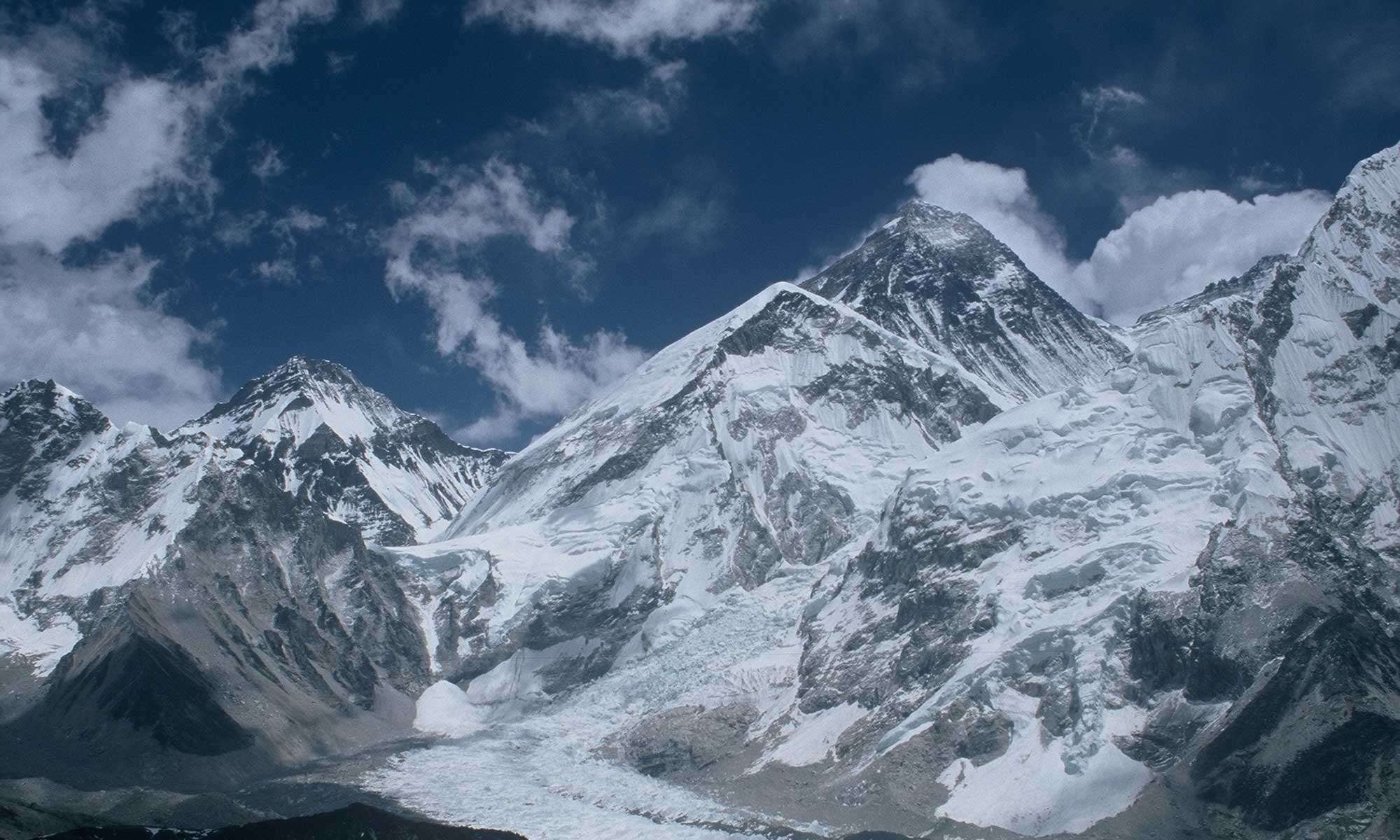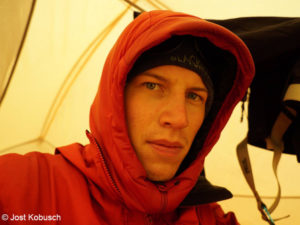“For me, time is the key to success,” says Jost Kobusch. And so the 27-year-old German mountaineer will already be heading for Nepal next Sunday – three months before the actual start of his expedition. Jost plans to climb Everest in winter, from the south side, over the Lho La (a 6,000 meter high pass to Tibet) to the West Ridge, through the Hornbein-Couloir to the summit – without bottled oxygen, solo. Beforehand he wants to acclimatize in peace and climb a six- as well as a seven-thousander, in preparation for the highest of all mountains.
The only mountaineer so far to stand without breathing mask on the 8,850-meter-high summit in winter was the legendary Ang Rita Sherpa, on 22 December 1987, exactly at the beginning of the calendrical winter. Some purists argue that Ang Rita ascended in the meteorological winter (which begins on 1 December), but in the calendrical fall – and that it was therefore, strictly speaking, not an Everest winter ascent.
Jost Kobusch wants to start his expedition at the beginning of the calendrical winter and finish it before the end of the meteorological winter (29 February). “The beginning of December and March doesn’t feel like winter for me,” says Jost.
In 2015, Kobusch became internationally known in one fell swoop when he shot a video of the avalanche, which – triggered by the devastating earthquake in Nepal – came down from Pumori, hit the base camp at the foot of Mount Everest and killed 19 people. At that time Kobusch actually wanted to climb Lhotse. In 2016 he scaled Annapurna, his first eight-thousander, without bottled oxygen. In 2017 he succeeded in the first ascent of the 7,321-meter-high Nangpai Gosum II in eastern Nepal, also without breathing mask.
Jost, you haven’t tried an eight-thousander in winter so far. Why immediately Mount Everest, the highest mountain on earth?
Because the goal is Everest and there is no better training than trying the actual goal.
You want to climb via the West Ridge, then through the Hornbein Couloir to the summit. Why did you choose this challenging, rarely used route?
It has to do with the fact that as a solo climber I can hardly climb through the Khumbu Icefall. A flow rate up to 1.8 meters per day, huge seracs, crevasses. I would have to employ Sherpas to lay ladders through the icefall. Assuming Alex Txikon shows up there and establishes a route through the icefall – that could be, I’ve heard rumours about that. Then I wouldn’t want to use his ladders anyway. That doesn’t fit into a solo for me. I am a purist, that would gnaw at me. That’s why the idea is to approach the West Ridge via Lho La. This route is technically very demanding, but offers a rather direct access with relatively low objective dangers compared to the Khumbu Icefall.
But you would later be in the Hornbein Couloir in the middle of the North Face. This isn’t exactly hiking terrain.
Absolutely, and it’s also shady compared to the normal route where it’s sunny. But there are also advantages. I hope that the wind will blow the snow off the West Ridge relatively bright and that – in contrast to the Western Qwm – I won’t have any problems with deep snow and can move quickly. Deep snow would be a knockout criterion for me as a solo climber. And at a height, where the wind becomes critical, I have a certain protection by the Hornbein Couloir. But of course this is only a hypothesis. In the end it’s a mountain, and the conditions are dynamic, in winter anyway.
In 1963, Tom Hornbein and Willi Unsoeld traversed the summit and descended via the normal route on the south side. Is that also your plan?
No. If Alex Txikon is really there and the route exists, one might see it as an emergency option. But I plan the expedition minimalistically and actually want to descend via the ascent route.
How minimalistic will you be climbing? Are you planning an Alpine style ascent or high camps?
I won’t set up high camps in the classic expedition style, at most small material depots where I leave some gas and food behind. I always have my tent with me. I would like to spend a night at 8,000 meters before a possible summit attempt, spend some rest days at 4,400 meters and then try a push.
But let’s be realistic. If I reach 8,000 meters at all, that would be a mega success. It is a gigantic project. The first thing is to find out what is possible under these conditions. Maybe I’ll come back and then I’ll tell you: No, forget the route, it can’t be solved that way.
I want to gain a lot of experience under the conditions under which I will one day climb Everest in winter. Maybe that’s often misunderstood. People say: Jost will make the summit. But that’s not the way it’s meant to be. It’s a big lesson for me.
So you’re taking the expedition rather than a test?
Absolutely. Of course, as a mountaineer you always want to reach the summit, and you set off because you think it is possible. But the chances are, realistically speaking, very, very small. I know that. And I approach the project much more humbly than it may often appear in the media. It’s absolutely no shame when I turn around. My personal goal would be to reach an altitude of about 7,200 meters. All above that would be bonus, the summit anyway. I see it more like a boulder problem where I put the details together. It is of course an expensive training. (laughs) But I think it can be successful in the end.
You want to climb without breathing mask. So far there was only one winter ascent of Everest without bottled oxygen, by the legendary Ang Rita Sherpa in 1987. Recently, the Spaniard Alex Txikon failed twice in attempts without breathing mask. What makes you optimistic that you can make it?
Honestly, I don’t think that I can already stand on the summit this time. What makes me optimistic is that I have an unusual approach. I just make it unconventional when I go there and see it as a training. I’m willing to return several times and work on the details. I like to be strategic. This increases the chances of success.
What do you say if someone says that the risk is irresponsible and accuses you of being a gambler?
Of course, I take a high risk on an Everest winter ascent. It’s a departure into the unknown. And exploration always means risks. You have to accept that. I try to keep the relative risk as low as possible.
How much risk would you take?
I’m actually someone who doesn’t want to take any risks at all. I’m not a gambler, I’m more a poker player. I look into my cards and don’t risk anything until everything is in order. I don’t play Russian roulette.
Recently you’ve been often solo climbing, for instance in 2017 on your first ascent of the seven-thousander Nangpai Gosum II. Now you’re starting without a team again. Are you a loner?
I am not a lonesome wolf. I love climbing with people, for example in the Dolomites. But when I go solo, I’m in a different mode. For me it’s like meditation, a deep flow. I’m just there and there’s nothing I have to do. It all flows. I then feel very connected to my environment. I make all the decisions myself.
I also see it as a maturation process. I wouldn’t go so far as to say that I return from every solo as a completely new person, but with new insights or a new perspective. That’s what I’m looking for.
So you don’t need headphones in order not to get on your nerves?
In fact, I like to have music with me. But it underlines this feeling. When you look out of the tent and listen to really good music, those are really cool moments in which time becomes unreal. It flows unusually, neither fast nor slow. The feeling for space and time blurs in those moments when you are alone and not talking.
How does your personal environment react to your Everest solo project?
On the Internet the reactions are quite extreme. There are haters who say it’s a suicide squad and that I am an egomaniac. Others think it’s absolutely awesome and overdo the whole thing. The people who really know me are worried, but on the other hand they also think the project is mega cool. Of course it’s a risk. However, if you do something that everyone does, you won’t be criticized either.
Last spring Everest was again in the headlines because of the many people on the mountain. Did this encourage you to try Everest not in spring but in winter?
I myself have been in a traffic jam before, in 2015 in the Khumbu Icefall, standing under a serac shone by the sun. Then the walkie-talkie goes on – like the radio on the motorway – and predicts a traffic jam for hours at the next ladder. That turned me off a lot.
On the other hand, I always found Everest fascinating. And it made me sad that one could no longer live out alpinism in this hype. That’s why I try Everest in winter.
In addition, I follow the principle: find a goal that is so difficult that it lasts as long as possible! If you make it, you kill the goal and have to look for a new one. So if you choose a goal that you can reach directly, it is too easy.






One Reply to “Jost Kobusch: “8000 meters would be a mega success””
Comments are closed.